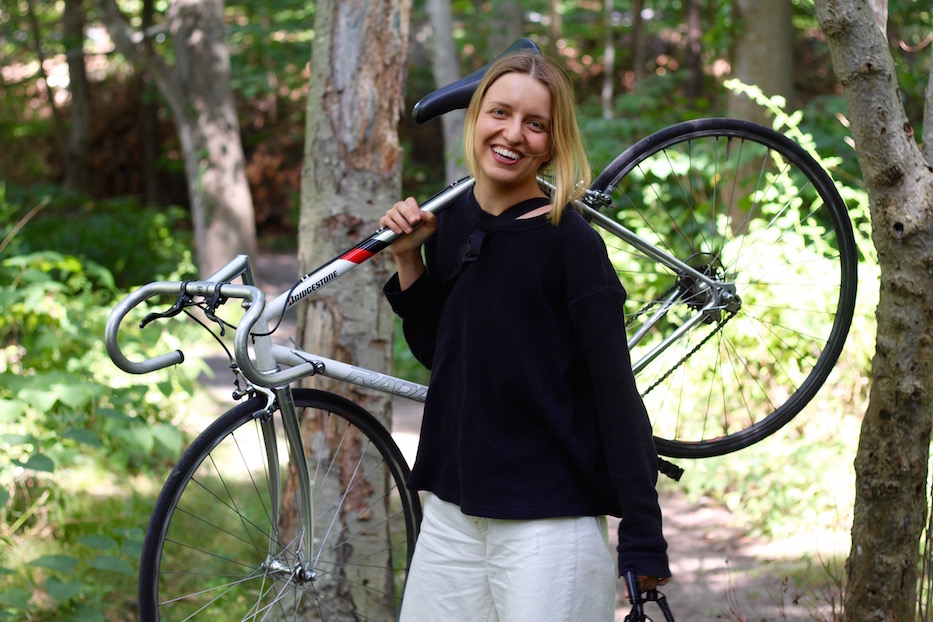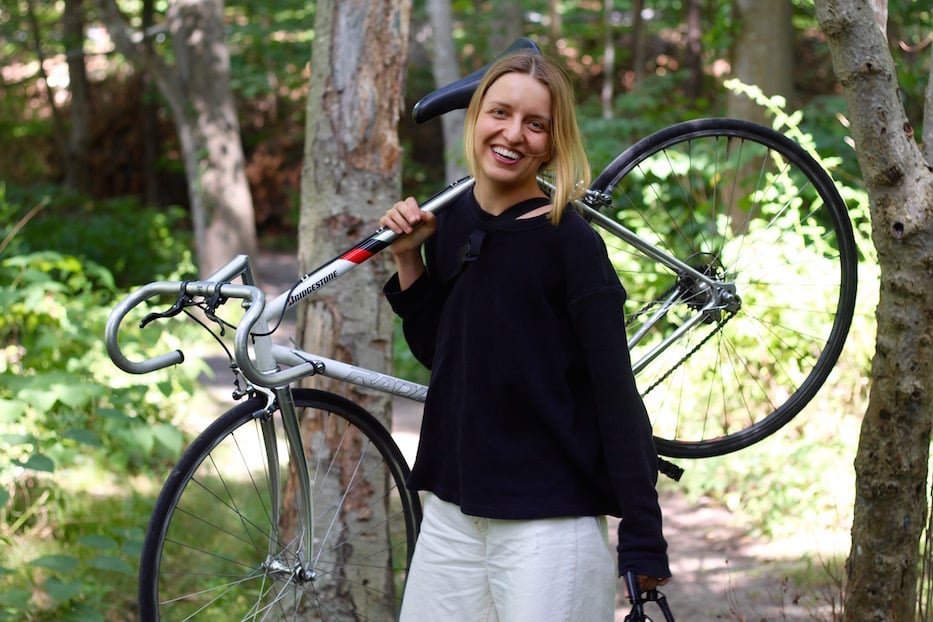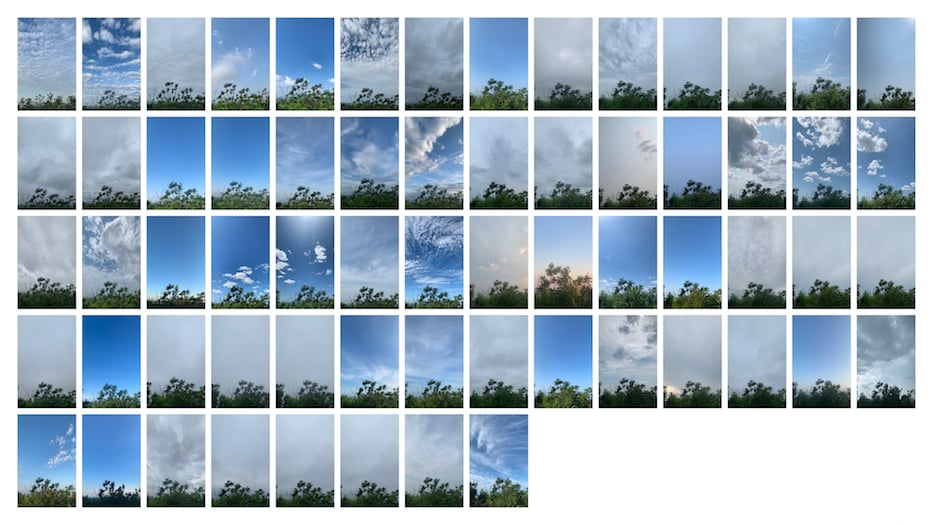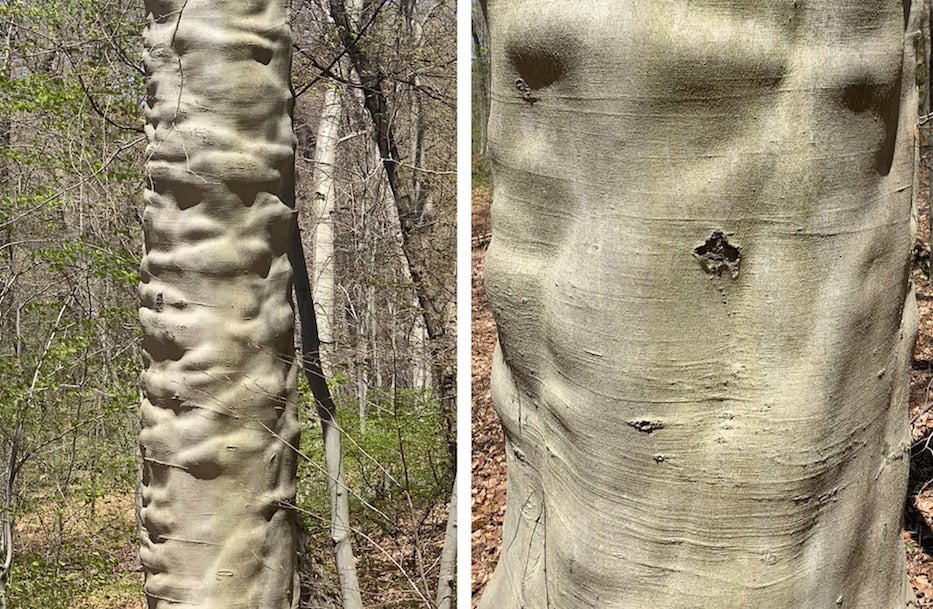
Design | East Rock | Arts & Culture | COVID-19

Orysia Zabeida in East Rock Park. Lucy Gellman Photo.
The tiles of sky line up just so, smears of blue and grey that are contained by their frames. In some, clouds stretch out toward the horizon line, wisps of white against the sky. In others they hang low, their bellies distended and full of rain. A few shots have no clouds at all, as if the clear sky could just reach down and touch the flowers.
The grid of 64 New Haven skies—and counting—comes from artist Orysia Zabeida, a multidisciplinary designer and graduate of the Yale School of Art who lives in the city’s Dwight neighborhood. After working with galleries, museums, and fellow artists across multiple countries, she has a new client: mother nature.
Since the beginning of the pandemic, Zabeida has visited East Rock Park nearly every morning, communing with the white-tailed deer, black vultures, and yellow-bellied slider turtles who live in its woods. In turn, the park has become an extension of her studio, pushing her towards a more sustainable practice as the world grapples with a massive climate crisis.
"I feel like that park is just saving my life," she said in a recent interview outside of the Yale University Art Gallery, watching as the sun created patterns on the bricks nearby. "If I didn't have the park, I don't know where I would be. It re-centers you, and it makes you remember why you're doing certain things. It just makes you a better person.”
 Zabeida, who is 29, was born in western Ukraine and spent most of her youth in Montreal. Before moving to New Haven in 2018, she studied visual communications at the Université du Québec à Montréal and worked at the PHI Center and PHI Foundation for Contemporary Art. During her time there, she worked with clients including the Icelandic artist Björk.
Zabeida, who is 29, was born in western Ukraine and spent most of her youth in Montreal. Before moving to New Haven in 2018, she studied visual communications at the Université du Québec à Montréal and worked at the PHI Center and PHI Foundation for Contemporary Art. During her time there, she worked with clients including the Icelandic artist Björk.
Since coming to New Haven, she has served as a designer for the Yale University Art Gallery, NXTHVN, and the Harvard Art Museums among others. As a student at the Yale School of Art and designer at YUAG, she assisted on exhibition catalogues, translated graphics to the web, and helped organize Odds and Ends, a book fair that ran at the gallery from 2014 through 2019.
In school, Zabeida experimented with her conceptual work on what she called “a colossal playground” in an interview with the writer Emily Gosling earlier this year. She fell in love with its collaborative approach. Then in March of 2020—her last semester of graduate school—the pandemic hit.
The exhibition that she and classmates had been working on for months, titled On My Way!, was postponed indefinitely (they later presented the show in the spring of 2021, and will be publishing a zine this fall). Graduation went online. Several of her friends and colleagues left New Haven, meaning that she was suddenly alone. She turned to East Rock Park for comfort, and found an explosion of new material waiting for her.
Zabeida started visiting the park in April 2020, after Mayor Justin Elicker closed English and Farnam Drive to cars. It was the first time she felt totally safe on the road, she said: the designer was involved in a serious cycling accident when she moved to New Haven four years ago. Suddenly, she had a clear path to the summit, like her bike could get her that much closer to the sky.

The "Muscle Tree." Orysia Zabeida Photos.
She started noticing the park’s natural quirks, from tree bark that looked like a rippling abdominal wall (“I call it the muscle tree,” she laughed) to animals that were there almost every day. While working remotely for the Los Angeles-based firm Day Job—a job she called “a miracle” in the pandemic’s bleak hiring landscape—it gave her a space to clear her head.
She would spend the morning biking to the park, and then return from that outdoor sanctuary to a home studio, her head buzzing with ideas. As she sat down to do branding built for the earth's human consumers, her mind often drifted back to the natural world.
"It was so inspiring," she said of the park. "Textures, colors—I think it really re-centers me. It calms me down."
Over time, it made her start thinking about how to make her own practice more environmentally sustainable. Zabeida typically rides in the early mornings, when the air is still cool. Months ago, she began picking up detritus that she saw along the trails, where people discard everything from surgical masks to soda cans. Those, too, became a kind of series, chronicling a jarring disregard for nature.


Orysia Zabeida Photos.
In each shot, she holds a manmade object in her outstretched palm, its soiled and pockmarked surface slow to decompose. Tiny nip bottles are some of her most frequent finds.
She started photographing clouds on May 21 of this year—at 6:57 a.m. to be exact—when she was feeling particularly isolated. After a few days, they started to become “some documentation of my perseverance,” as she biked up and down the mountain, snapped a shot at the summit, and then worked through a quiet, isolating and anxiety-ridden year for artists.
She lined them up in a grid that has continued to grow, comparing the certainty of the sky to its shifting, malleable parts.
Together, the photographs weave a distinct, ongoing and endearingly organic love letter to the park—and to her own process of coming professionally into herself. While they are charged with references to high art, from Horace-Bénédict de Saussure's cyanometer to John Constable’s nineteenth-century cloud studies, they are also down-to-earth evidence that she is here, ready with her cell phone camera to chronicle another day.
"That's one of the good things about the pandemic," she said. "It makes people think about what really matters."
Now, she’s more attuned to the changing seasons and the way the river swells and contracts with rainfall. She delights in finding new routes and seeing how the undergrowth changes after a heavy rain. She knows, within a span of minutes, when the same morning hiker will reach the summit, fling his arms wide and proclaim “Thank You Lord!”
It has also made her think about the fact that environmental sustainability and design aren’t mutually exclusive, she said. As a field, design may prioritize the turnover of consumer-ready goods—splashy fast fashion or eye-catching fast food wrappers for instance—but it doesn’t have to. She pointed to potentially working with an educational or municipal entity, such as a city, to create longer-lasting design strategies that care for the planet and both its human and nonhuman inhabitants.
As she broadens her scope, the park continues to serve as a source of inspiration. She is currently working on a video project that takes a closer look at the Goose Dam, which sits at the far edge of the park off Whitney Avenue in Hamden. Like East Rock itself, she said, she finds the structure mesmerizing, from its tumbling sheets of water to its intervention on the natural landscape.
She has continued to add to her daily practice of sky images, with a grid that now numbers over 70. To them, she’d added images of deer, turtles, and wild birds, placed beside each other as if they are printouts from a photo booth. In so doing, she is not just capturing them through her lens—she is making a visual argument for their existence and survival.
"As a designer, you're making things,” she said. “And I don't want to make bad packaging. I want to educate people about not littering. If it's branding, it has to be for missions or companies that are doing good. That are helping."
On a recent Monday, she walked briskly through the sun-dappled woods, keeping her eyes out for trash on the ground and any small woodland friends who might be nearby. With delight, she ambled down a new path, clearing a branch that had fallen as she stepped closer to the water. The afternoon light bounced over her black sweatshirt and white pants.
She studied the tall, overgrown grasses and cautiously tested a muddy patch, where extra rainfall had left a bloom of red salvia. She crossed the trail and stood by the lip of the water, watching as a frog disappeared beneath the surface.
Then she looked down the path, and kept going.

